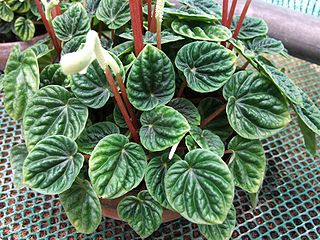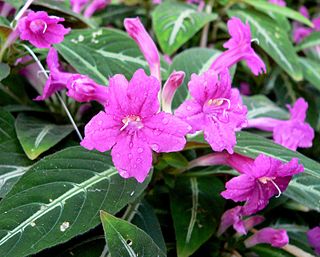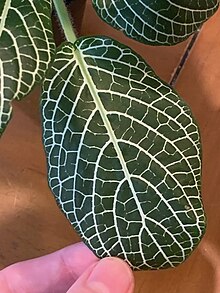
Alstroemeria, commonly called the Peruvian lily or lily of the Incas, is a genus of flowering plants in the family Alstroemeriaceae. They are all native to South America, although some have become naturalized in the United States, Mexico, Australia, New Zealand, Madeira and the Canary Islands. Almost all of the species are restricted to one of two distinct centers of diversity: one in central Chile and southern Argentina, the other in eastern Brazil. Species of Alstroemeria from Patagonia are winter-growing plants, while those of Brazil are summer growing. All are long-lived perennials except A. graminea, a diminutive annual from the Atacama Desert of Chile.

Impatiens walleriana, also known as busy Lizzie, balsam, sultana, or simply impatiens, is a species of the genus Impatiens, native to eastern Africa from Kenya to Mozambique. The Latin specific epithet walleriana honours a British missionary, Horace Waller (1833–1896).

Dracaena trifasciata is a species of flowering plant in the family Asparagaceae, native to tropical West Africa from Nigeria east to the Congo. It is most commonly known as the snake plant, Saint George's sword, mother-in-law's tongue, and viper's bowstring hemp, among other names. Until 2017, it was known under the synonym Sansevieria trifasciata. This plant is often kept as a houseplant due to its non-demanding maintenance; they can survive with very little water and sun.

Fittonia is a genus of evergreen perennial flowering plants in the acanthus family, Acanthaceae. The genus is native to tropical and subtropical forested areas in northern and western South America, mainly Perú.

Coleus scutellarioides, commonly known as coleus, is a species of flowering plant in the family Lamiaceae, native to southeast Asia through to Australia. Typically growing to 60–75 cm (24–30 in) tall and wide, it is a bushy, woody-based evergreen perennial, widely grown for the highly decorative variegated leaves found in cultivated varieties. Another common name is painted nettle, reflecting its relationship to deadnettles, which are in the same family. The synonyms Coleus blumei, Plectranthus scutellarioides and Solenostemon scutellarioides are also widely used for this species.

Goeppertia makoyana, also known as peacock plant or cathedral windows, is a species of plant belonging to the genus Goeppertia in the family Marantaceae, native to Espírito Santo state of eastern Brazil. It has gained the Royal Horticultural Society's Award of Garden Merit.

Ctenanthe oppenheimiana, the giant bamburanta or never-never plant, is a species of flowering plant of family Marantaceae and is a native of Brazil. It is an evergreen perennial. This plant can grow to more than 1 m (3.3 ft) tall and broad, with long narrow leaves up to 40 cm (16 in) in length. The leaves are adorned on the secondary veins with dark green bands, which meet and merge in the margins. In between are cream coloured bands. The undersides of the leaves have a red-ish colour. The cultivar 'Tricolor' is a common ornamental variety, which as a houseplant in the UK has gained the Royal Horticultural Society's Award of Garden Merit.. This cultivar is visually very similar to Stromanthe Sanguinea 'Triostar', and the two are often confused. The difference between the two lies in the lack of regular banding on the leaves of the Sromanthe, and the generally more rounded shape of the leaves in Ctenanthe.

Goeppertia zebrina, the zebra plant, is a species of plant in the family Marantaceae, native to southeastern Brazil. It is sometimes known by the synonym Calathea zebrina. Goeppertia zebrina has gained the Royal Horticultural Society's Award of Garden Merit.

Hypoestes phyllostachya, the polka dot plant, is a species of flowering plant in the family Acanthaceae, native to South Africa, Madagascar, and south east Asia. The spots often merge into larger areas of colour.

Peperomia caperata, the emerald ripple peperomia, is a species of flowering plant in the family Piperaceae, native to Brazil. It is a mound-forming evergreen perennial growing to 20 cm (8 in) tall and wide, with corrugated heart-shaped leaves, and narrow spikes of white flowers 5–8 cm (2–3 in) long, in summer.

Goeppertia picturata is a species of plant now classified as belonging to the genus Goeppertia in the family Marantaceae. It has the synonym Calathea picturata.

Kalanchoe marmorata, the penwiper, is a species of flowering plant in the family Crassulaceae, native to Central and East Africa, from Zaire to Ethiopia, Sudan and Somalia. It is an erect or decumbent succulent perennial growing to 40 cm (16 in) tall and wide, with glaucous leaves spotted with purple, and starry white, four-petalled flowers, sometimes tinged with pink, in spring. As the minimum temperature for cultivation is 12 °C (54 °F), in temperate regions it is grown under glass as a houseplant.

Maranta leuconeura, widely known as the prayer plant due to its daily sunlight-dependent movements, is a species of flowering plant in the family Marantaceae native to the Brazilian tropical forests. It is a variable, rhizomatous perennial, growing to 30 cm (12 in) tall and broad, with crowded clumps of evergreen, strikingly-marked oval leaves, each up to 12 cm (5 in) long. The plant spreads itself horizontally, carpeting an entire small area of forest floor, sending roots into the substrate at each leaf node.

Peperomia obtusifolia, also known as the baby rubberplant, American rubber plant, or pepper face, is a species of flowering plant in the genus Peperomia under the family Piperaceae, native to Florida, Mexico and the Caribbean. The specific epithet obtusifolia means "blunt-leaved". The plant has gained the Royal Horticultural Society's Award of Garden Merit.

Philodendron erubescens, the blushing philodendron or red-leaf philodendron, is a species of flowering plant in the family Araceae, native to Colombia. It is a robust evergreen climber growing to 3–6 m (10–20 ft), with red stems and heart-shaped leaves up to 40 cm (16 in) in length. The flowers are deep red, fragrant spathes up to 15 cm (6 in) long, in summer and autumn. The specific epithet erubescens means "blushing".

Ruellia makoyana, the monkey plant or trailing velvet plant, is a species of flowering plant in the family Acanthaceae, native to Brazil. It is an evergreen perennial growing to 60 cm (24 in) tall by 45 cm (18 in) wide, with white-veined hairy leaves and trumpet-shaped pink flowers in summer.

Syngonium podophyllum is a species of aroid that is a popular houseplant. Common names include: arrowhead plant, arrowhead vine, arrowhead philodendron, goosefoot, nephthytis, African evergreen, and American evergreen. The species is native to a wide region of Latin America from Mexico through Bolivia, and naturalized in the West Indies, Florida, Texas, Hawaii, and other places.

Plectranthus oertendahlii is a species of flowering plant in the sage and mint family, Lamiaceae. Common names include silverleaf spurflower, Swedish ivy, Oertendahl's spurflower, November lights and Brazilian coleus, though it is native to eastern South Africa rather than Brazil. Plectranthus oertendahlii and the cultivar 'Uvongo' have gained the Royal Horticultural Society's Award of Garden Merit.

Goeppertia roseopicta is a species of flowering plant in the arrowroot and prayer-plant family Marantaceae, native to northwestern Brazil's Amazonian basin. Oftentimes, it is marketed as a houseplant under its former generic name and synonym Calathea roseopicta. It is a clump-forming, evergreen perennial, growing to 50 cm (20 in), and is very similar in appearance to G. makoyana. The typical "wild-type", or "natural" form, has papery, ovate leaves of a pastel, seafoam-green hue, outlined with a dark-green edging and "painted" horizontally from the midribs with darker streaks; typical of other species in its family and genus, G. roseopicta features dark reddish, purplish backsides to its foliage, an evolutionary adaptation to growing in darkened or shaded areas on the forest floor, where adequate light reflection is required for photosynthesis.






















